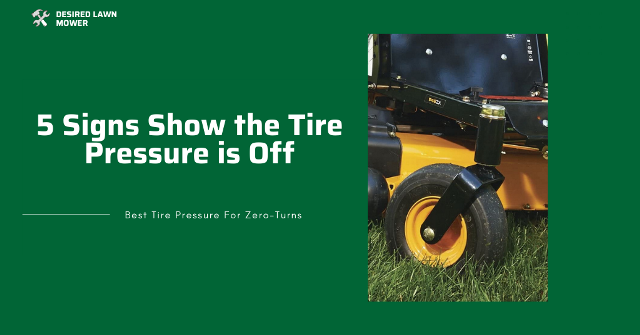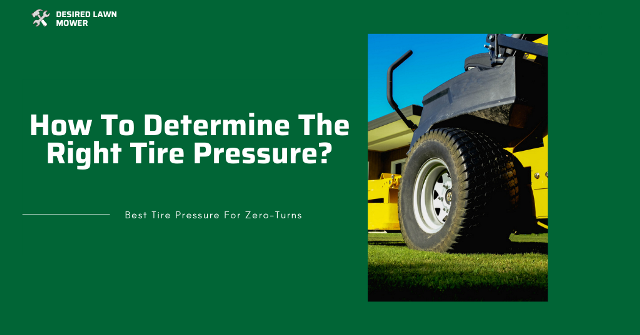If you’re wondering if there is a constant tire pressure for all zero-turn mowers, the answer is NO. Every riding mower’s tire pressure varies depending on grade (residential or commercial) and weight, thus the pressure cannot be the same.
Usually, tire pressure works hand in hand with traction. If your traction is off – your zero-turn mower slips off, or leaves skid marks – the first thing to check is the tire pressure which, for 9 out of 10 scenarios, is the culprit. The other one percent could be tied to the wellness of the tire itself, not the pressure of the tire. However, I’m here for all the pressure what-have-you, which is what we’d be mostly tackling in this article.
All zero-turn mowers come with their required maximum pressure that serves as the safest point for both the front and rear tires. It is also a standard for the air pressure in the front tire to be greater than that in the rear.
You’ll find the maximum measure on the sidewall of the tires, and in most cases, it never exceeds 30psi for both the front and rear.
There’s a lot to know about this topic, so let’s get into it right away!
What is The Overall Best Tire Pressure For Zero-Turn Mowers?
The overall best tire pressure for all zero-turn mowers is 14psi at the front, and 10psi at the rear. The reason why the pressure in the front tires is greater than in the rear is to aid in the proper distribution of the weight of the zero-turn mower. If the rear tires have a greater amount of pressure, the agenda for traction will be completely defeated and dangerous to consider.
Now, you might be wondering why you find a different value on the sidewall of your zero-turn tire. Perhaps you find 22psi or 25psi on the sidewall of your tires and you’re wondering why it isn’t 14psi like I mentioned earlier. The number you see on the sidewall of your tire is the number you shouldn’t exceed no matter what because it is considered highly unsafe.
When a zero-turn mower is put together, in most cases the tires are made by a different manufacturer; they have no idea what manner of terrain the tires will ride over, but they know exactly how much pressure will be harmful no matter the terrain. It is then up to you to figure out which pressure suits your terrain the most.
This is why you might have been thrown off by the several “best pressure” answers you got when you checked the web. The replies may be correct, but they are from different yard tenders with uniquely featured yards.
Tell-tale Signs The Tire Pressure Is Off on Your Zero-Turn Mower

Many things could go wrong due to improper zero-turn tire pressure. Your problem could be listed in these points. Read on to find out!
- Infuriating Cut Quality
Uneven or wrong tire pressures could cause the deck of your zero-turn mower to wobble along with the entire machine, leading to an uneven cut. If the tires are overinflated, bouncing and rumbling will be frequently observed and, in turn, affect the cut quality of your turf.
- Skid Marks And Scalping
Less traction equals more skid marks. If the tires of your zero-turn mower are shaped like a donut, tight turns and quick brakes will cause the tires to scrape on the surface since there isn’t enough surface area for traction. This is also very risky; the zero-turn mower can lose balance and tumble over which could result in grave consequences.
- Very, very poor Traction
If the tires are way over or way less in a measure of pressure, the traction will be nothing to write home about. It’s either there wouldn’t be enough grip by the tires to pull you up the slope, or there wouldn’t be enough spinning force to do so. Also, it can affect your tires and rot them away because of the strain of friction you’d encounter going up a hill.
- Front Tires Keep Slipping Off At Every Impact
Exceeding the suitable PSI could cause the front tires to bounce or slip off their wheels at the smallest impact of force. If this has happened before or is currently happening, trust me, the tire pressures are off. I advise you to check them out to be sure it’s intact.
- Horrible Ride Quality
If your riding mower’s tires are too full or way less than required, you will have a horrible time steering through the yard. Going over bumps will be a mind-numbing encounter and maneuvering your path will be stressful to do. If you experience any of this to a degree, you better suspect your tire’s pound per square inch.
How To Know The Best Tire Pressure For Your Zero-Turn Mower

Since the best tire pressure is determined by unique features belonging to your zero-turn mower and your yard, here’s how to know the best for you:
- Climate Matters; Hot & Cold Weathers Affect Tire Pressure
Air pressure will significantly decrease in colder climates and increase in hotter climates. It is important to know how your climate affects the PSI of the tires. You may have to peep in now and then to ensure the tires are not under or over-inflated.
So if you mow in intense weather conditions and you adjust the PSI to the desired number, when you realize the slightest change in cutting quality or traction, it could be due to the climate. The colder the climate, the more pressure you will need for your tires because cold temperatures influence air pressure negatively. The opposite is the case for hotter climates.
- Front and Rear Equal Tire Pressures Do Well With Bumps
If your mower beats you to a stupor when you ride around your yard, the problem may be the distribution of impact you get from climbing over bumps. Try setting the tire pressures on an equal PSI for both the front and rear – say 8psi for all four tires – to help distribute the effect accordingly.
- For Steep Slopes, The Front Tires Should Be Greater By 4 – 5 psi
When you’re climbing an elevated plain, the distribution of weight is very crucial for your safety. That is why it’s a standard rule for the front tire psi to be greater than the rear tires. That way, you have enough weight at the front to drag you up a hill, and enough wedge to aid you down safely.
How To Regulate The Tire Pressure on Your Zero-Turn Mower
First, you need a tire pressure gauge to measure the PSI of your zero-turn mower’s tires. If you don’t have one, you can easily purchase a good gauge like the AstroAl digital gauge (view on Amazon) for just a few bucks –they give highly accurate results.
With your pressure gauge in hand, pop opens the pressure valve and latch the gauge onto it to take a measure. Now that you know the current pressure of the tires, you can compare and contrast to see if you need air reduction or increment.
- To Increase The Air Pressure Of Your Tires
You will need an air compressor for this task. If you don’t own one, you can visit the gas station. They always have air compressors. Before you embark on this step, you should know what pressure is best for you. With the number in hand, slowly pump in the air in short intervals making sure to not exceed your desired mark. If you’re not sure of your desired mark, you can add air and run the mower around for a few minutes. Although I understand this would be rather time-consuming, it does pay in the end.
It’s even better and cost-saving if you have a good portable compressor at home. That way you can test-run around the features of your yard to decide which works best for you. Here’s my favorite compressor (view on Amazon); the accuracy and speed are perfect for quick tire pressure checks and fixes. I advise you to get one for the long run so that you can keep track of your tire pressure.
- To Decrease The Air Pressure of Your Tires
This is very easy to do. Take a blunt slender object like a key or a pen, then poke the tire valve to let the air hiss out. Do this also at short intervals and measure at every stop to be sure you don’t exceed your desired PSI.
An Interesting Tip For Checking Tire Pressure
You can check your zero-turn mower tire pressure by running across a wet puddle! It sounds ridiculous but it works. All you have to do is drive into a puddle of water and out to open dry concrete. If the tire prints appear thin, very threaded, and neatly printed, then the pressure is too high. If you find the prints to be a little blurry and just the same width as the tire, then you’re good to go.
If the tires are flat, you’d almost find no patterns on the tire print at all. It would also appear to be a little wider than the actual width of the tire.
Finally, The End of Our Trip
Always check your tire pressures because a lot of problems could be avoided if the pressure is set correctly. You might be having the worst ride of your life and loathe mowing completely because your tires have 1psi extra or less. Make sure to have a pressure gauge and tire inflator ready for grabbing.
Also, NEVER EXCEED the pound per square inch you find marked on your tires. There’s no reason to even try to– it’s not worth the hazard you will encounter. You’re allowed to decide which pressure suits you best below the mark and I suggest you take advantage of that greatly! It’s all you and the breeze when your tires are filled correctly, I guarantee you that.
